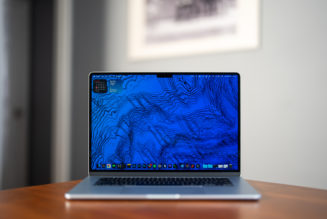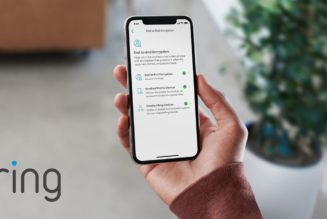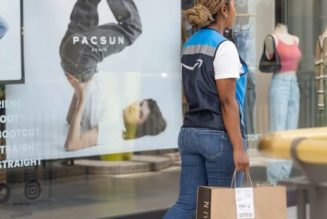
Ana* and her three-year-old son arrived at the shelter for migrant and refugee women in the northern Mexican city of Monterrey in early October. Every morning, the 14 women at the shelter — mainly from El Salvador and Honduras — share the house chores: sweeping, cooking, and babysitting the children of their compañeras working informal jobs to save enough money to cross into the United States.
The majority of them, traveling alone with as many as three children, spent days unable to communicate with their families after crossing Mexico’s southern border. Not having a local SIM card, they said, made the uncertainty and anxiety of their journey that much worse.
For a family crossing the border, a working phone is critical. It lets asylum-seekers stay connected to family, receive money, and access critical information for their journey. But refugees and asylum-seekers face enormous challenges keeping those phones working, as the logistics of cellular networks work against them. The result is a constant scramble, as refugees swap SIM cards and wrestle with telecoms in an effort to create a safer migration journey for themselves and their families.
Ana lost contact with her family after crossing the Guatemala-Mexico border. She didn’t know how to change a SIM card and couldn’t find a place to charge her phone, which ran out of battery in Guatemala.
“My family hadn’t heard from me. Once at the shelter, I went out and found a little shop where I had to pay 15 pesos per hour to charge it and bought a chip for 80 pesos. Then, I called my family,” explains Ana.
Losing mobile coverage when entering Mexico deprives people in transit from being monitored and accompanied by their support network. While telecommunication infrastructure has expanded across borders with expensive international roaming plans, people trying to move freely across those same borders are being left with limited access to mobile services.
Vladimir Cortés is the digital rights program officer in the Mexico and Central America office of Article 19, a nonprofit focused on freedom of expression. Cortés explains that governments, multinational telecommunication corporations, regulatory bodies, and international organizations could establish continuity of access to mobile services for people in migration.
“International organizations can articulate these different actors to guarantee mobile network coverage,” says Cortés. “There is an important opportunity to recognize the phenomenon that currently exists and the level of protection that states can guarantee.”
Six months ago, Ana and her son left their home in Choluteca, Honduras, after receiving threats from the people who kidnapped and killed her 14-year-old daughter Gabriela*. Throughout the journey, Ana, who aspires to build a safe life with her son in Los Angeles, relied on Google Maps to check her location, and WhatsApp or Facebook to communicate with her family.
“In some parts there was a signal and in others not. When there was no internet, I was left with nothing,” says 37-year-old Ana, while her son watches SpongeBob SquarePants on her Samsung Galaxy S6.
The use of GPS applications and instant messaging apps — mostly Facebook and WhatsApp — allows refugees to orient themselves and participate in online migrant networks that can give them a greater sense of community and security. Some of the women at the shelter said it’s hard to trust information available online, since they are aware of online scams that falsely promise visa facilitation and transportation assistance.
Some of these online scams have been linked to serious criminal activities such as kidnapping and human trafficking. Diana González and Juan Manuel Casanueva, researchers at SocialTIC, a Mexican digital security nonprofit, identified various connectivity risks at Mexico’s southern border such as identity theft and extortion.
“The dangers are basically associated with two: identity theft for extortion issues, meaning some type of information can be used to contact their families and ask for money,” explains Casanueva. “And the other is not entirely digital … it’s the lack of communication. If they are victims of other types of danger, they cannot communicate with a support network.”
The women at the shelter often verify online information with their compañeras or other offline sources, such as staff at the shelter or migrant rights groups, since they know Facebook is used to spread misinformation and fake news.
“Saying Facebook is bad or WhatsApp is bad does not apply. It is the only thing there is,” says Casanueva. “The question that should be asked in these spaces is how these people can have the appropriate information, and also how to prevent risks that occur on these platforms, such as identity theft for issues of extortion and scams, criminal networks, and possibly even risk of kidnapping, and lots of fake news.”
Ana limits her mobile use to messaging her family, seeking information about border crossings, and watching cartoons with her son. Masha and the Bear is her favorite since, she says, “it helps to distract” her mind.
Mary left El Salvador with her three children, ages two, five, and eight, after being extorted at the pizza place she owned, and like Ana, she doesn’t like to use her Huawei Y7P unless out of necessity.
“The truth is, I don’t use the phone much more than the girls use it to watch videos to entertain themselves. I just want to know how my father and brothers are, and if my brother who is in the United States is going to send me money,” says Mary, who withheld her full name for her own protection.
For the women in the shelter, the priority is to earn more money so they can find safer ways to cross. When they were able, many took buses instead of walking, or stayed in hotels instead of shelters, to protect their children throughout their journey toward the US-Mexico border.
Esther Nohemí Álvarez lent her Huawei phone to her 15-year-old daughter, who was starting to show symptoms of depression. It was 2019, and the Migration Protection Protocol, a Trump era policy also called “Remain in Mexico,” was forcing thousands of asylum seekers arriving at the US’s southern border to remain in Mexico to await their US hearings.
Álvarez’s daughter grabbed her mom’s phone and did TikTok dance challenges with other girls at the shelter. That same phone allowed her to stay in contact with her mother in Monterrey and with her father in Virginia, while she crossed the US-Mexico border with the assistance of a smuggler in April of this year.
“As an unaccompanied minor, immigration detained her and they contacted her father. She had her father’s number memorized in case her cell phone was taken away,” says Álvarez. “She was there for about 25 days, and they allowed her like three calls to contact her dad.”
Of all the risks that crossed Álvarez’s mind when she decided to send her daughter alone after her asylum claim was denied, digital risks were the least of her concern, let alone government surveillance.
But earlier this year, Mexico’s Senate passed a law that would require mobile users to register their biometric data in a government database in order to obtain a SIM card. The law will allegedly fight organized crime and reduce extortions and kidnappings, even though a similar project implemented between 2008 and 2011 only saw an increase in extortions.
Digital rights groups challenging the law affirm that users’ sensitive personal information will be at risk. Although the law is currently suspended indefinitely by the Supreme Court, Cortés explains that its implementation would generate a greater violation of the rights of migrants, who already face persecution by the Mexican National Institute of Migration and other state actors.
“The registration of the card is not the only problem. The other problem is the delivery of biometrics data. Authoritarian countries can use this as a way to control and undermine the privacy of people,” adds Cortés.
The first time Álvarez and her daughter tried to cross through Ciudad Miguel Alemán, across the border from Roma, Texas, they were held for a week in the hieleras, Customs and Border Protection’s notoriously cold detention cells. They were deported through Nuevo Laredo — a border city that has seen a surge in drug cartel-related violence — more than 150 kilometers away from their original point of entry. It was her mobile phone that allowed Álvarez to locate herself on a map and seek assistance.
As the US government deploys new technologies to surveil and track migrants, asylum-seeking women are not deterred by them. Even if they have to wait longer in Monterrey until they consider it safe to cross, returning home is no longer an option.
“We are going to cross the border. That’s why I’m working here [in Monterrey] to save money,” says Mary, while two of her kids run around the table. “If we don’t make it, then we are going to stay here because I cannot return to my country.”
*Some names in this story have been changed to protect sources from possible reprisals.









